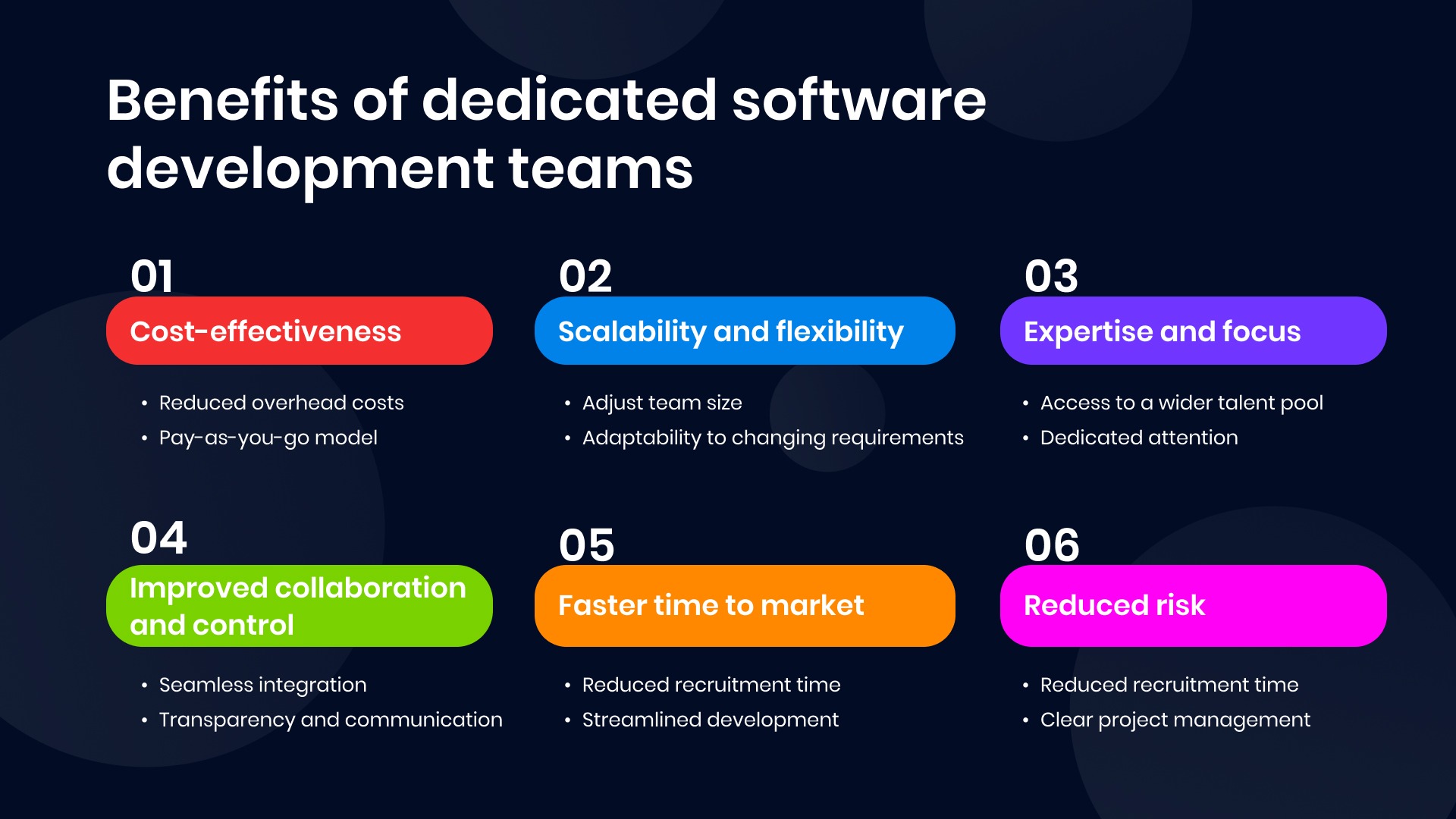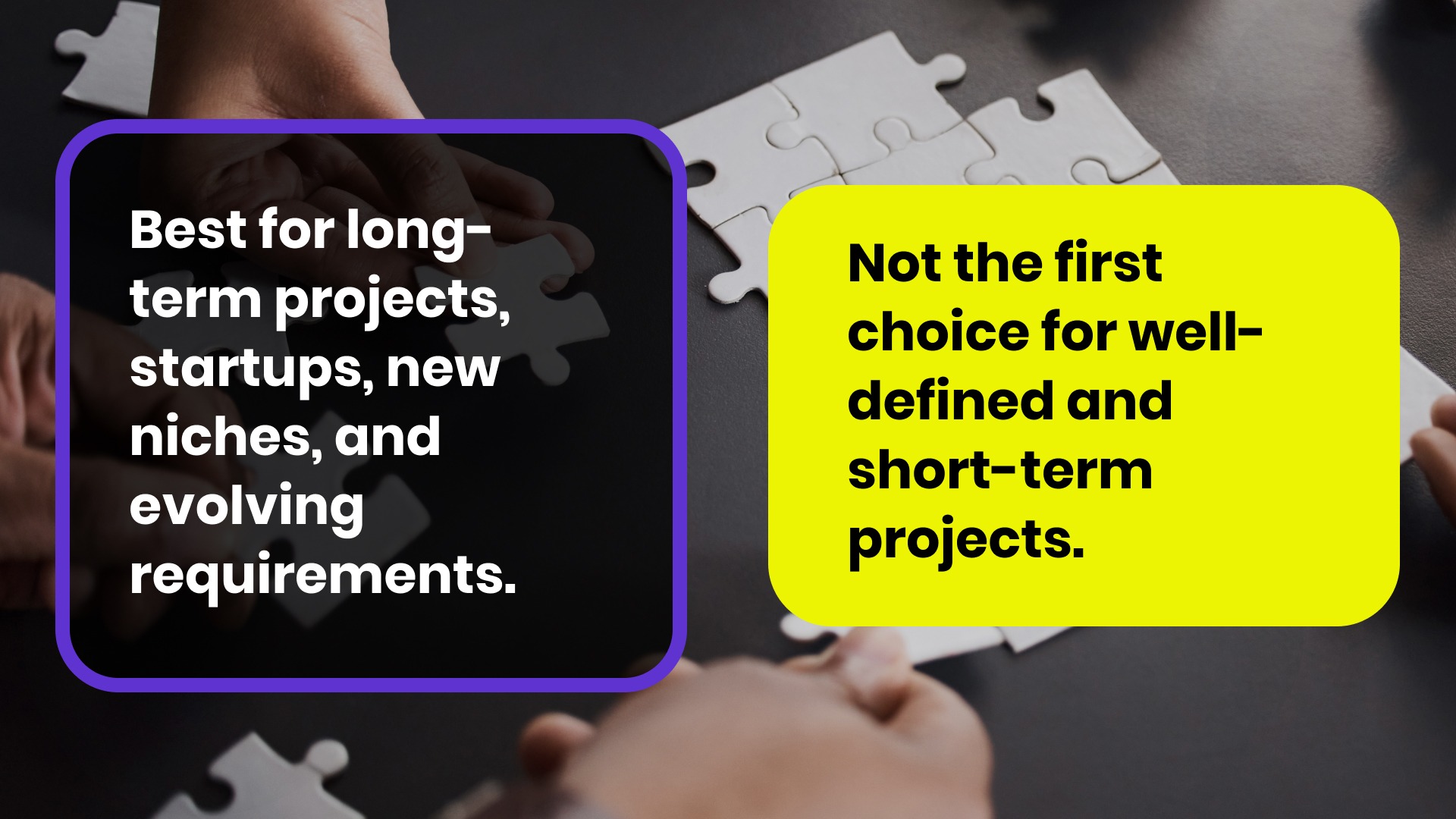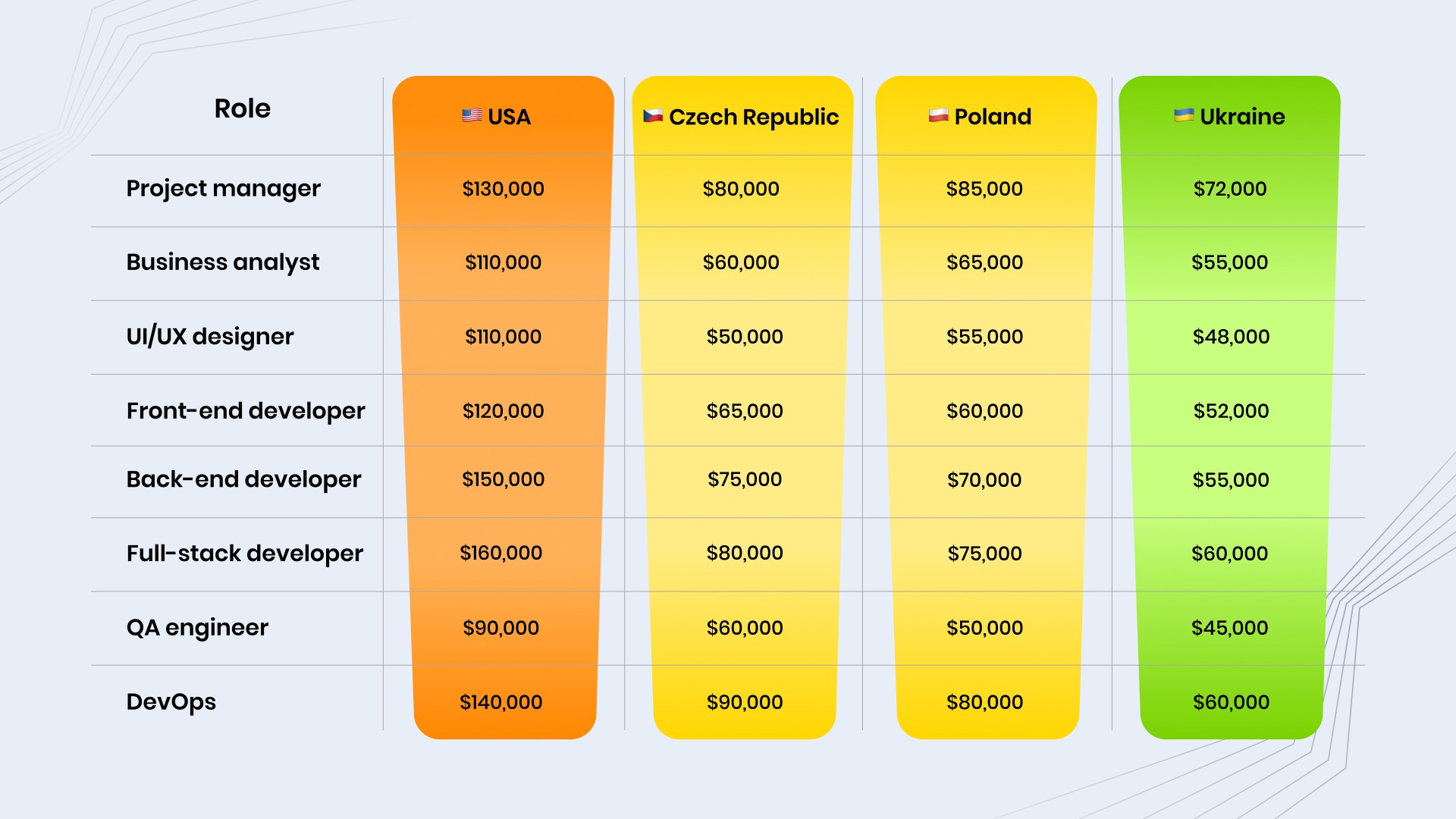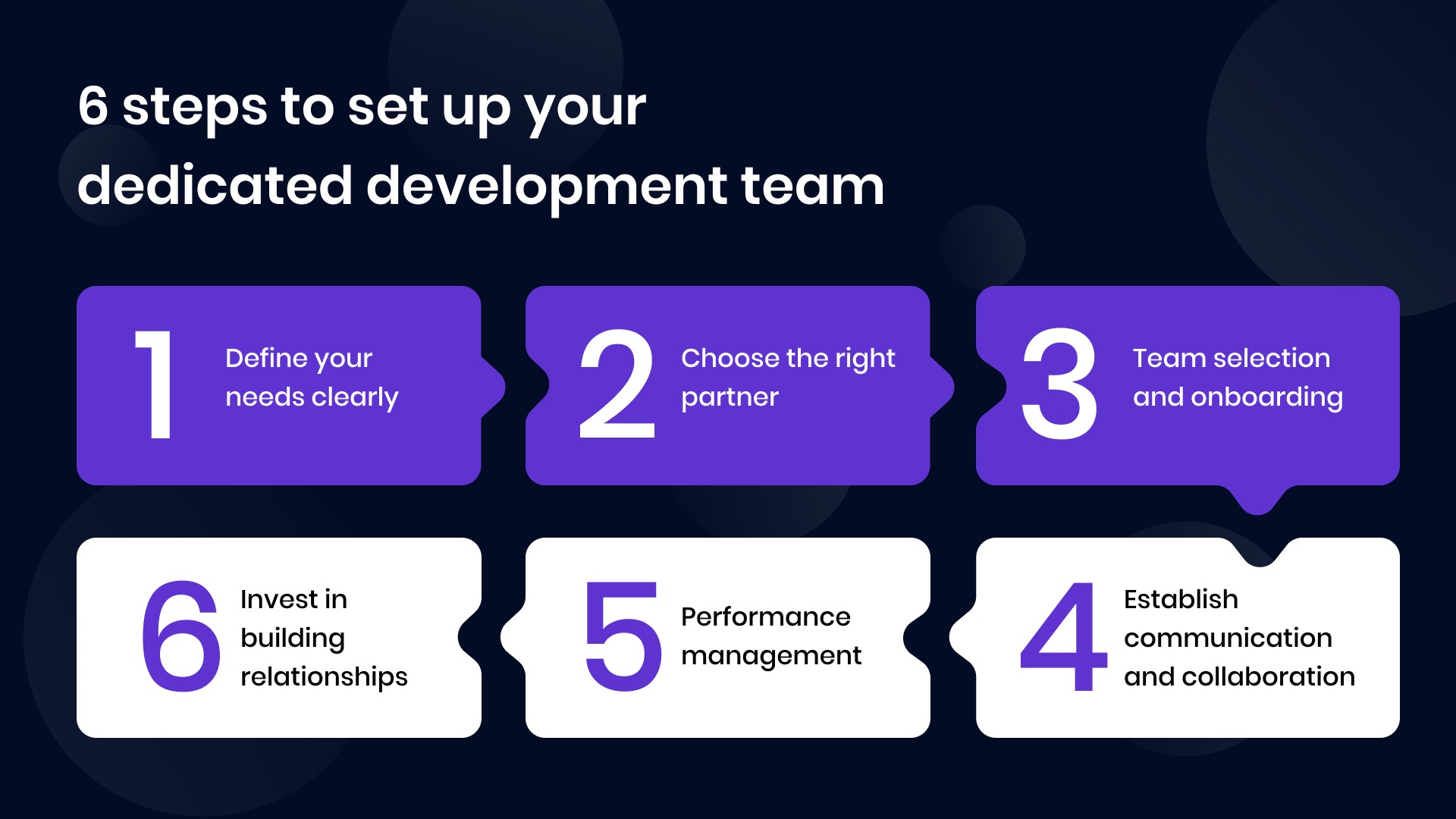
Edited on: 5 July, 2024
The dedicated software development team model is a popular outsourcing approach for businesses seeking skilled professionals to work on long-term projects. It offers a cost-effective and scalable solution compared to building an in-house team. But how do you ensure a successful setup for this model? This guide will equip you with the knowledge to navigate the process effectively.
Content:
- How does a dedicated development team work?
- Understanding the benefits of dedicated teams
- When to hire a dedicated team?
- The dedicated development team: A symphony of expertise
- How much money do you save when hiring a dedicated team?
- 6 steps to set up your dedicated development team
- How does MWDN hire a dedicated team for your business?
How does a dedicated development team work?
The dedicated development team model emerged as a solution for tighter client control over outsourced teams. This model integrates the team more closely with the client’s business processes, ensuring true dedication to the project at hand.
Unlike traditional developer outsourcing, dedicated teams avoid juggling multiple projects for different clients. Instead, they essentially function as an extension of the client’s organization for all aspects directly related to the project’s work.
Meanwhile, the service provider takes care of recruitment, motivation, HR tasks, legal support, payroll, taxes, and operations. This frees the client from administrative burdens, allowing for faster team building and quicker focus on the project itself.
This efficiency boost makes perfect sense. On average, 68% of companies spend over a month hiring a single developer. With a dedicated team model, this effort is significantly reduced, freeing resources for other areas. Furthermore, a survey reveals that 40% of CTOs see outsourcing as a way to manage rapid industry changes, while 42% utilize it for quick scaling. The dedicated team model offers businesses the benefits of outsourcing while achieving the collaboration typically associated with an in-house team.
In essence, a dedicated team feels like an in-house extension, but the client only expends resources on the project itself.
Understanding the benefits of dedicated teams
The dedicated software development team model offers several advantages for businesses looking to outsource development projects. Here are some of the key benefits:

1. Cost-effectiveness
- Reduced overhead costs. Save on expenses associated with recruitment, training, office space, and employee benefits for an in-house team.
- Pay-as-you-go model. You only pay for the time and expertise the dedicated team spends on your project.
2. Scalability and flexibility
- Adjust team size. Easily add or remove developers based on project needs, ensuring optimal resource allocation.
- Adaptability to changing requirements. The dedicated team can adapt its focus and skillset as your project evolves.
3. Expertise and focus
- Access to a wider talent pool. Tap into a global network of skilled developers beyond your geographical limitations.
- Dedicated attention. The team focuses solely on your project, leading to faster development, higher quality, and a deeper understanding of your goals.
4. Improved collaboration and control
- Seamless integration. The dedicated team becomes an extension of your in-house team, fostering close collaboration.
- Transparency and communication. Maintain clear communication channels and project management processes for better control.
5. Faster time to market
- Reduced recruitment time. The outsourcing partner handles the recruitment and onboarding process, saving you valuable time.
- Streamlined development. The dedicated focus on your project leads to faster completion and quicker launch.
6. Reduced risk
- Experience and expertise. Partnering with a reputable outsourcing company provides access to experienced developers and proven methodologies.
- Clear project management. Established processes and performance evaluations minimize risks associated with project delays or quality issues.
When to hire a dedicated team?
The dedicated development team model shines in specific scenarios where long-term collaboration and project complexity are key. Here are the cases when hiring a dedicated team should be your first choice.

You have a long-term project. By its nature, a dedicated team fosters deeper understanding and accumulates project-specific knowledge over time. This is invaluable for complex projects that unfold over extended periods.
You’re a startup seizing opportunities. For startups with limited resources, a dedicated team provides a fast and efficient way to build a skilled workforce and capitalize on fleeting market opportunities. Imagine launching your product quickly with a team already onboarded and in sync with your vision.
Your product constantly adapts to evolving requirements. Dedicated teams excel in projects where requirements may shift or become clearer as the project progresses. The close collaboration fosters flexibility and allows them to adapt to changes.
You navigate unfamiliar territory. Companies venturing into new niche markets often lack in-house expertise. A dedicated team with relevant experience can provide the specialized skills and knowledge needed to navigate unfamiliar terrain.
In contrast, projects with well-defined, short-term goals might be better suited for alternative collaboration models. Dedicated teams are built for sustained involvement and excel at managing complex projects over time.
Overall, consider the dedicated development team model as an investment in building a long-term partnership with your development team. This fosters trust, communication, and a deep understanding of your project, ultimately leading to better results.
The dedicated development team: A symphony of expertise
A dedicated software development team functions like a well-rehearsed orchestra, each member playing a crucial role in creating a successful project. The core team typically includes:
- Project manager (Conductor). The maestro oversees the entire project. They ensure smooth communication, manage tasks and deadlines, and keep everything on track.
- Business analyst (Translator). Bridging the gap between business goals and technical requirements. They translate your vision into actionable steps for the development team.
- UI/UX designers (Architects). Crafting the user experience, the architects who define how users interact with the product and influence development tasks to create a seamless experience.
- Developers (The Band). The heart of the team that brings the project to life with their coding expertise. Their skills can vary depending on the project, but they all work together to create the final product.
- QA engineers (Quality assurance team). The meticulous critics, ensuring the product is flawless through various testing methodologies. They identify and fix bugs before they reach the audience.
Depending on your project’s specific needs, your dedicated team may also include additional specialists beyond the core, like DevOps specialists, product owners, marketing specialist, and industry consultants.
The beauty of the dedicated development team model lies in its flexibility. By adding or removing specialists based on project needs, you can assemble the perfect team to ensure your project’s success.
How much money do you save when hiring a dedicated team from Eastern Europe?
The key reason the dedicated teams model is so popular is that it can save you a lot of money, particularly on direct labor costs. How does it happen? Due to differences in salary levels in different regions.
Check out the average annual salaries for different technical roles in the USA and some Eastern European countries.

In MWDN, we hire dedicated teams all around the globe, including Eastern and Western Europe, Israel, and South and North America. By hiring tech talent in countries with lower levels of salaries, you can save up to 60% just on direct labor costs.
6 steps to set up your dedicated development team
While the dedicated team model relieves the customer of the typical headaches of recruiting, screening, and HR-related issues, there still are some “lifehacks” to keep in mind when building the team. Following these and understanding the general process, can help maximize the benefits of the chosen collaboration model.

1. Define your needs clearly
1.1 Outline your project’s objectives, functionalities, and desired timeline. Having a clear roadmap will guide team selection and project management.
1.2 Identify the specific technical skills and experience needed for your project. This ensures you assemble a team with the right qualifications.
1.3 Determine the size of the team based on project complexity and workload. Consider the core roles like project manager, developers, and QA engineers, and expand with specialists as needed.
2. Choose the right partner
2.1 Research outsourcing companies. Look for a reputable IT vendor with a proven track record and experience in your industry.
2.2 Consider factors like communication style, cultural compatibility, security standards, and their team selection process.
2.3 Review case studies. See examples of their previous work to understand their approach and expertise in handling projects similar to yours.
3. Team selection and onboarding
3.1 Work with your chosen partner to select the most qualified developers based on your project requirements. This often involves reviewing profiles and conducting interviews.
3.2 The dedicated development team model involves a two-step onboarding process. The outsourcing company handles initial onboarding, taking care of administrative tasks like payroll, equipment setup, and benefits. Project onboarding is a customer-led onboarding focusing on the project itself. Clearly explain processes, roles, and establish routines and practices for efficient teamwork. Additionally, identify crucial company information for the dedicated team and facilitate introductions to key personnel they’ll collaborate with.
4. Establish communication and collaboration
4.1 Set up clear communication channels like video conferencing platforms, instant messaging tools, and project management software.
4.2 Schedule regular meetings (daily stand-ups, weekly reviews) to maintain open communication and discuss progress updates, roadblocks, and solutions.
4.3 Foster transparency by sharing project information, expectations, and challenges openly with the team.
5. Performance management
5.1 Implement performance evaluation processes to ensure the team meets project goals and quality standards.
5.2 Establish clear feedback mechanisms to address concerns, provide constructive criticism, and keep the team motivated.
5.3 Conduct periodic project reviews to assess progress and make adjustments as needed. This might involve adjusting team size, composition, or methodologies.
6. Invest in building relationships
Treat the dedicated team as an extension of your in-house team. Foster positive and collaborative relationships for better communication and project outcomes.
How does MWDN hire a dedicated team for your business?
MWDN specializes in building dedicated development teams, leveraging our extensive experience in software development outstaffing.
We begin with a free consultation to ensure we fully understand your project needs. Then, we handle the entire process, from identifying and interviewing top talent to legal and operational support. This includes ongoing services like competence development, benefits management, team building, and performance reviews.
Drawing from diverse talent pools, primarily in Eastern Europe, we can assemble the perfect team to meet your specific requirements and extend your capabilities. Contact us today to discuss building your dedicated development team and unlocking the power of the right talent for your project.
Content
- 1 How does a dedicated development team work?
- 2 Understanding the benefits of dedicated teams
- 3 When to hire a dedicated team?
- 4 The dedicated development team: A symphony of expertise
- 5 How much money do you save when hiring a dedicated team from Eastern Europe?
- 6 6 steps to set up your dedicated development team
- 7 How does MWDN hire a dedicated team for your business?


